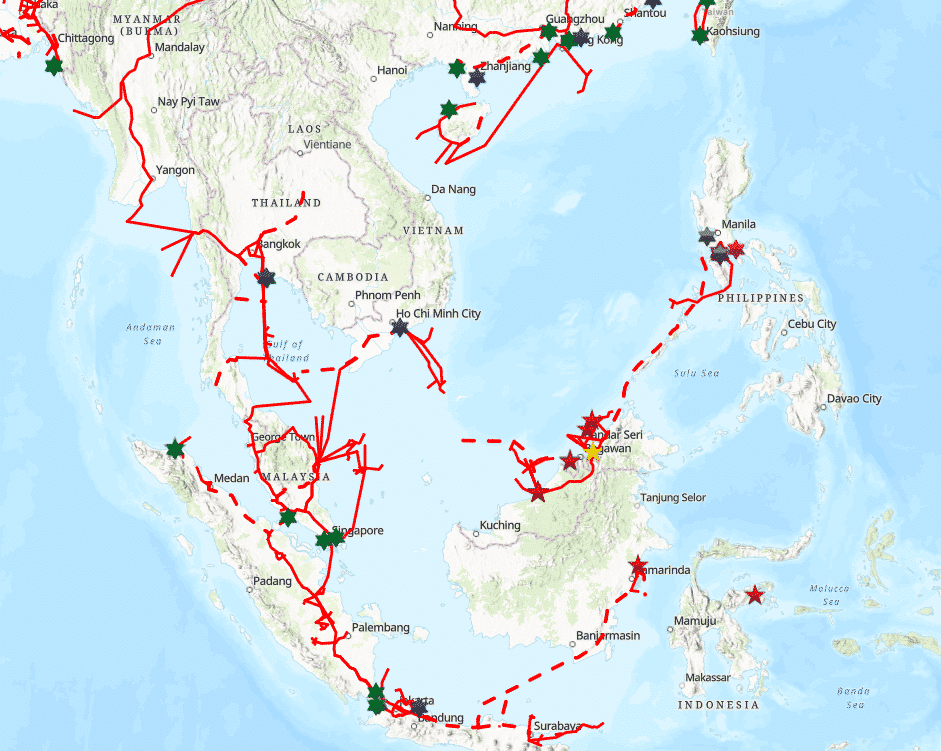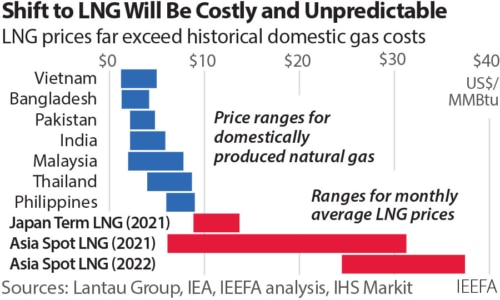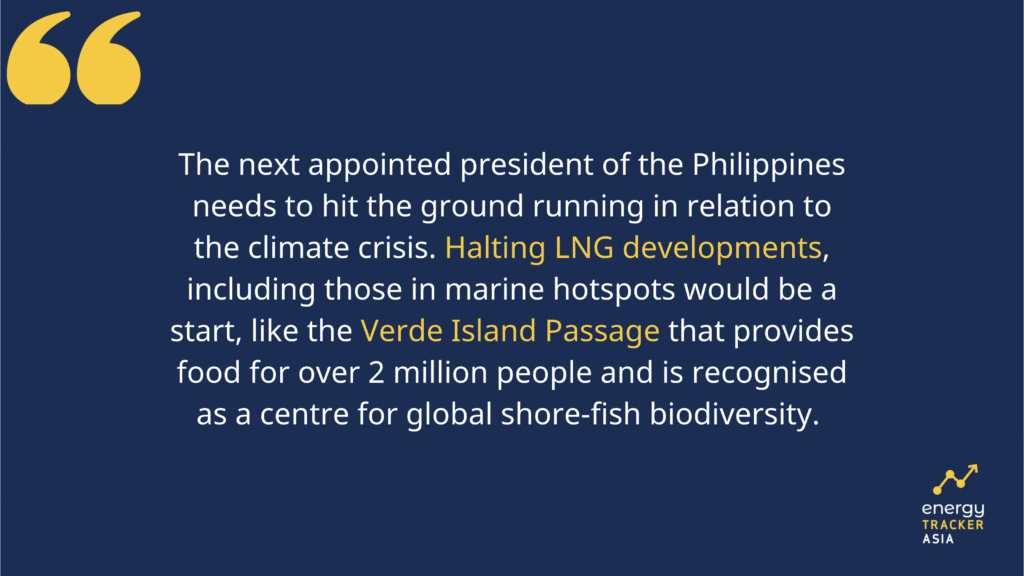The Philippines’ Presidential Candidates 2022 Should Pursue Renewables and Halt LNG
06 May 2022 – by Viktor Tachev Comments (0)
The winner among the Philippines’ presidential candidates will have many uphill battles ahead. The future leader will need to find a way out of the country’s massive LNG pipeline plans and ease the public opposition against them. Achieving these aims will ensure enormous support and, most importantly, guarantee a more sustainable and self-sufficient energy system for the country.
The LNG Market Boom and Presidential Candidates Philippines
As of 2020, fossil fuels accounted for about 79% of the country’s power generation mix. Natural gas holds a 22% share. However, this figure is poised to almost double in the following years to over 40% by 2040.
Today, there is over 29 GW worth of gas power plant projects in the pipeline. More than 21 GW of them are active, meaning they are either included in the Department of Energy’s lists of proposed projects, announced in the news or issued clearance for system impact studies and other screenings.
Such massive fleet expansions are often portrayed as beneficial for a country’s economy and its energy future. However, LNG has no place in a world that is marching towards decarbonisation. Its environmental impact aside, LNG also bears massive financial, energy security and reputational risks. However, for the Philippines, the implications of these problems are even more glaring.

The Impacts of the Massive LNG Fleet Expansion Plans for the Philippines
Communities, organisations and environmentalists in Batangas, where two LNG projects are now in advanced development stages, recently conducted a fluvial demonstration in Verde Island Passage. The area provides food to over 2 million people and is recognised as the centre of global shore-fish biodiversity. In addition to fueling the climate crisis, the groups claim that the projects are a threat to marine life and their livelihoods.
In a 2021 report, the Institute for Energy Economics and Financial Analysis (IEEFA) cautioned against LNG developments in the country due to price volatility. The institute found that only 29% of the Philippines’ LNG projects are viable. IEEFA views the role that LNG plays in the energy mix of the Philippines as being a “fuel of last resort”.
Last but not least, there is also an energy dependency problem. Despite the country’s intensifying energy woes caused by the declining and unstable gas supply from the Malampaya field, expanding the LNG infrastructure through new terminals and capacity are unlikely to solve the problem.
Instead, doing this will make the country less self-sufficient from an energy perspective. It will also lock the country into a fossil-fuel-dominated future worth USD 14 billion in stranded assets. Avoiding such a scenario is crucial, as Filipinos are already grappling with rising fuel and food costs due to the Russian invasion of Ukraine. According to IEEFA, countries like the Philippines may face further challenges in securing LNG imports due to the war’s long-term impact. As a way out, IEEFA suggests the adoption of cleaner, domestically-sourced renewables.

The Role of the Presidential Candidates in the 2022 Philippine Presidential Election In Solving the Problem
Energy has been a heated issue among the Philippines presidential candidates. Those with problematic stances on the energy transition are threatened to be called out.
Once appointed, the next president needs to hit the ground running when it comes to the climate crisis. The focus should be on halting the LNG developments in the Philippines. This includes the ongoing projects in the marine hotspot Verde Island Passage. A move like this will set the newly elected president on a course for strengthened support. Furthermore, it will bring down a notable barrier standing in the way of the country’s decarbonisation progress. It will also ensure massive economic and energy self-sufficiency benefits along the road.
Developing and capitalising on the Philippines’ vast renewable potential could make a difference. It will help curb carbon emissions and move the country away from its import-oriented energy system, which currently relies on gas. According to campaigners, the country’s next leaders should start the shift to renewable energy by raising its share in the energy mix to 50% by 2030, improving the environment for green investments and speeding up the fossil fuel phaseout.
Renewables as the Single Best Option
The Philippines has marked steady progress on the clean energy stage. However, in recent years, the country has taken a step back. The overall share of renewables in its total electricity generation fell from 34% in 2008 to 21% in 2021.
The National Renewable Energy Program (NREP) has set a target of a 35% share of renewables in the power generation mix by 2030. By 2040, it should be up to 50%. The Philippines also is aiming for a 75% emission reduction by 2030. The government launched the 2040 Philippine Energy Plan (PEP) to lay out plans for the country’s energy system.
These targets are realistic enough, considering the country’s massive clean energy potential. A recently-released road map by the Department of Energy (DOE) and the World Bank Group (WBG) shows that the Philippines has the potential to install 21 GW of offshore wind power with the right long-term vision, infrastructure development, investment and policies. Other experts see a much higher technical potential, possibly reaching up to 178 GW of offshore wind capacity.
Ushering in a transition to a new energy era in the Philippines is a logical and much-needed next step. Scaling up renewables will provide a cheaper and faster decarbonisation route than building and retiring fossil fuel infrastructure.

The Way Forward After the 2022 Philippine Presidential Elections
All the candidates in the Philippines Presidential election have already voiced their support for the renewable energy transition. However, it will be up to the elected leader to put these words into action. Experts accept that renewable energy is or will soon become cheaper than gas across the entire region. Economic benefits aside, the winner of the election has many other reasons to curb the progress of the LNG industry and prioritise renewables.
The Philippines is already among the countries most vulnerable to climate crisis. However, as Greenpeace notes, what the country is experiencing will only worsen as global temperatures continue to rise. Due to this, the next leader should be looking to change the country’s energy policy course. Fossil fuels have taken it to where it is today, but renewables can provide a way out. And on the 9th of May, Filipinos will vote with that in mind.

by Viktor Tachev
Viktor has years of experience in financial markets and energy finance, working as a marketing consultant and content creator for leading institutions, NGOs, and tech startups. He is a regular contributor to knowledge hubs and magazines, tackling the latest trends in sustainability and green energy.
Read more



